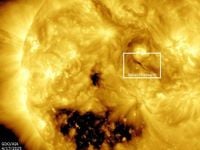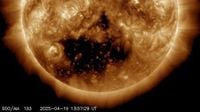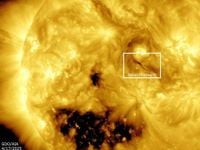As Easter Monday approaches, the Earth is bracing for a solar storm caused by a massive coronal hole that has opened on the Sun. This celestial event is expected to unleash a strong solar wind directed toward our planet, with significant implications for technology and nature.
The coronal hole, which boasts a diameter of hundreds of thousands of kilometers, is positioned in the southern and central regions of the solar disk, aimed directly at Earth. According to the Space Weather Prediction Center of the National Oceanic and Atmospheric Administration (NOAA), this phenomenon will result in a G2 geomagnetic storm, classified as moderate on a scale that ranges from G1 (minor) to G5 (extreme).
On April 21, 2025, the solar storm is expected to manifest its effects, bringing with it a variety of potential disruptions. NOAA experts have warned that voltage problems in energy systems, especially in regions at high latitudes, could occur. Additionally, transformers might sustain damage if the storm persists for an extended period.
"A G2 storm is not entirely harmless," said Valentina Penza, a researcher at the Solar Group of the University of Tor Vergata in Rome. "We can expect voltage issues in energy systems and possible damage to satellites, which may require orbit corrections from ground control centers. Blackouts and anomalies in high-frequency (HF) radio communications are also anticipated."
Moreover, the storm could affect wildlife, as alterations in the migratory behavior of animals that rely on magnetoreception for navigation are expected. Such changes can significantly impact species that migrate across vast distances.
Coronal holes are intriguing structures that appear dark when observed in high-energy wavelengths, such as X-rays and extreme ultraviolet light. Penza explained, "In these regions, the plasma is a bit cooler and less dense. This is due to the fact that they are unipolar regions of the magnetic field, which is open, allowing solar wind to flow freely into space." The current coronal hole is indeed a substantial one, with its size comparable to dozens of Earth-sized planets lined up side by side.
While G2 storms are less intense than those triggered by Class X solar flares and coronal mass ejections (CMEs), they can still pose risks. The plasma emitted during such storms interacts with the Earth's magnetic field, leading to geomagnetic storms of varying strength. Penza noted, "Typically, storms caused by coronal holes are less violent than those resulting from flares, but they are not without their challenges. We will have to wait until April 21 to gauge the actual impact of this event."
Interestingly, forecasts indicate that auroras at Italian latitudes are not expected this time around, despite the potential for spectacular displays in other regions. The anticipation surrounding this solar storm highlights the delicate balance between solar activity and its effects on Earth.
In the days leading up to the storm, scientists have been monitoring solar activity closely. Notably, two coronal mass ejections occurred on April 12 and 13, which may have contributed to the current situation. "These CMEs can originate from solar flares or eruptive prominences," said Mauro Messerotti, a professor of Space Meteorology at the University of Trieste, commenting on the recent solar events.
The geomagnetic storm that was predicted for April 16 is already in progress, with the first CME hitting the Earth's magnetic field early on April 15. This early impact demonstrates the dynamic and sometimes unpredictable nature of solar weather.
As the solar storm approaches, it serves as a reminder of the powerful forces at play in our solar system. The interplay between the Sun and Earth can lead to breathtaking natural phenomena as well as technological challenges.
In summary, the impending solar storm on April 21, 2025, due to a massive coronal hole, is expected to bring moderate geomagnetic activity. While the effects may not be catastrophic, they could disrupt energy systems, satellite operations, and even animal migration patterns. The scientific community continues to monitor the situation closely, and as the event unfolds, it will provide valuable insights into the complex interactions between solar activity and our planet.






